3.12: Surrealism (1920-1950)
- Last updated
- Save as PDF
- Page ID
- 174422
Introduction
The Manifesto of Surrealism by André Breton was a publication for a literary movement based on experimenting with writing about the subconscious or dream states, the world of imagination, and irrationality. Earlier, Dada employed the disdain of traditional art instead of interjecting letters, photographs, and readymade objects. Dada provided a platform for the Surrealists to further move away from conventional art and into the unexpected. Early artists experimenting with Surrealism were from multiple countries, creating diverse and symbolic images emerging from the subconscious mind, a place of superior authenticity and the absence of control. Surrealist work was tense and sexual based on hidden psychological forces in the subconscious. The rational mind was suppressed, and imagination locked in by societal controls. They didn't look for art in real everyday life; instead, they used the impulses of the primitive unconscious mind.
Sigmund Freud also influenced Surrealism with his book, The Interpretation of Dreams. He wrote how dreams revealed real human emotion and cravings stemming from the inner mind and its revelation of sex, violence, and longing. Although they embraced Freud, they focused on the concept of idiosyncrasy instead of a view of madness. Imagery is the most distinguishable part of Surrealism, often eccentric, weird, or bewildering, meant to make the viewer uncomfortable and challenge their general assumptions of imagery and art. Elements of nature were frequently included in a painting, positioned in strange places, and juxtaposed against an illogical background. Early artists experimented with drawing automatically, not looking or thinking about the image, letting their inner psyche work, then completing the painting. Some of the artists supposedly used drugs to connect with their inner minds. In the past, religious beliefs of the mind were instrumental in creating remarkable masterpieces; for Surrealists, the release of the thoughts of the subconscious mind gave rise to this period's great works.
Communism was also an influential concept for Surrealists. Most of the artists were young and had just lived through the First World War and the chaos of the world's leaders. Communism manifestos in the 1920s provided a reasonable, at the time, alternative to the destructive bourgeois society and its economic domination. Many of the painters based their work on political ideals or struggles and revolutionary politics. By the 1930s, with Surrealism embraced by painters worldwide, the movement became a way to redefine ordinary objects into informal organization or meaning, bringing a feeling of alienation, a common position in the modern world. During World War II, many artists came to North America to escape the Nazis and Fascism, bringing their ideas of escapism and dream imagery.
During the 1900s, female artists achieved success, however, risking the tendency to be overshadowed by a male husband or lover. "…for women involved in the Surrealist circle, the situation was even more fraught. The Surrealists were fascinated by women: beautiful women, mad women, young women, or preferably all three conjoined in the ideal figure of the femme-enfant, the child-woman, whose untamed nature might be the conduit to a realm of fantasy and indulgence."[1] Male Surrealist artists generally used females as a symbol of unpredictability. Most of the female artists used different mythical or historical female figures to outmaneuver their imaged conditions, figures with some basis of power; a witch, fairy, crone, pixie, or sprite.
Max Ernst
Max Ernst (1891-1976) was born in Germany, attending the University at Bonn, originally studying philosophy before changing to art and becoming friends with some Post-Impressionists and Dadaists. He was conscripted into the German Army in World War I and served for four years. After the war, Ernst became part of the early Surrealism with André Breton and collaborated with Salvador Dali and Joan Miró. In the early 1930s, he had successful shows in New York before returning to France, wherein in 1939, Ernst was jailed as an enemy. In 1941, Ernst was able to escape and left with Peggy Guggenheim, whom he married. After the war, he divorced Guggenheim, married Dorothea Tanning, and returned to France.
Ernst used multiple mediums, including paint, collage, and printmaking, focusing on the unusual Surrealist ideas of automatically drawing from one's memory and subconscious. He invented a process called 'frottage' or 'decalcomania,' placing paper on top of the wood, mesh, or other textured surface and rubbing the surface with pencils or crayons, reproducing the textural image. When Ernst moved from paper to paint, his new method was 'grattage'; scraping the canvas laying on a texture to remove wet pigment and create different patterns. He believed the fragmented look of his collages represented the methodical displacement of culture, the disjointed elements in incongruous settings. Ernst had fought in World War I and fled World War II, his work often reflecting the subconscious brutality of war.
Parts of Surrealism were based on the unusual combinations of elements and colors. In Jardin Gobe Avions (5.12.1), Ernst used contrasting colors of oranges and blue-grey to set the desert-like scene. He painted an irrational juxtaposition of the perception of airplane parts combined with anthropomorphic floral arrangements, a shrimp flower or the seahorse flower. The features of the setting are segmented into strong angles of a wall- or bench-like planes. Ernst was fascinated with birds, even considering his alter-ego an extension of the bird's earlier metamorphosis into a human. He frequently used images of birds in his works, stemming from dreams. He believed his pet bird died as he lay sleeping, and then his sister was born.
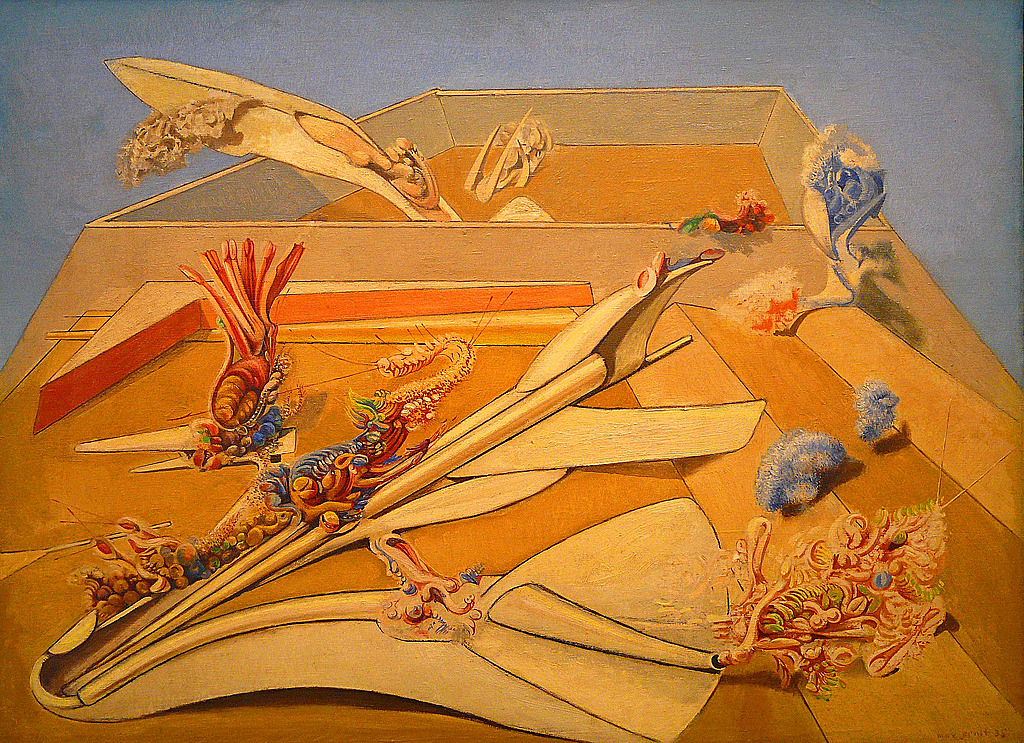
His sculpture Habakuk (5.12.2) was a pseudo tribute for the Jewish prophet, Habakkuk who condemned those who made idols. The sculpture's eyes were bug-like, cast from a stone found in the desert, a third eye on the figure's foot a perception of visionary power. He used flowerpots to model the body, stacked in a way to resemble movement.
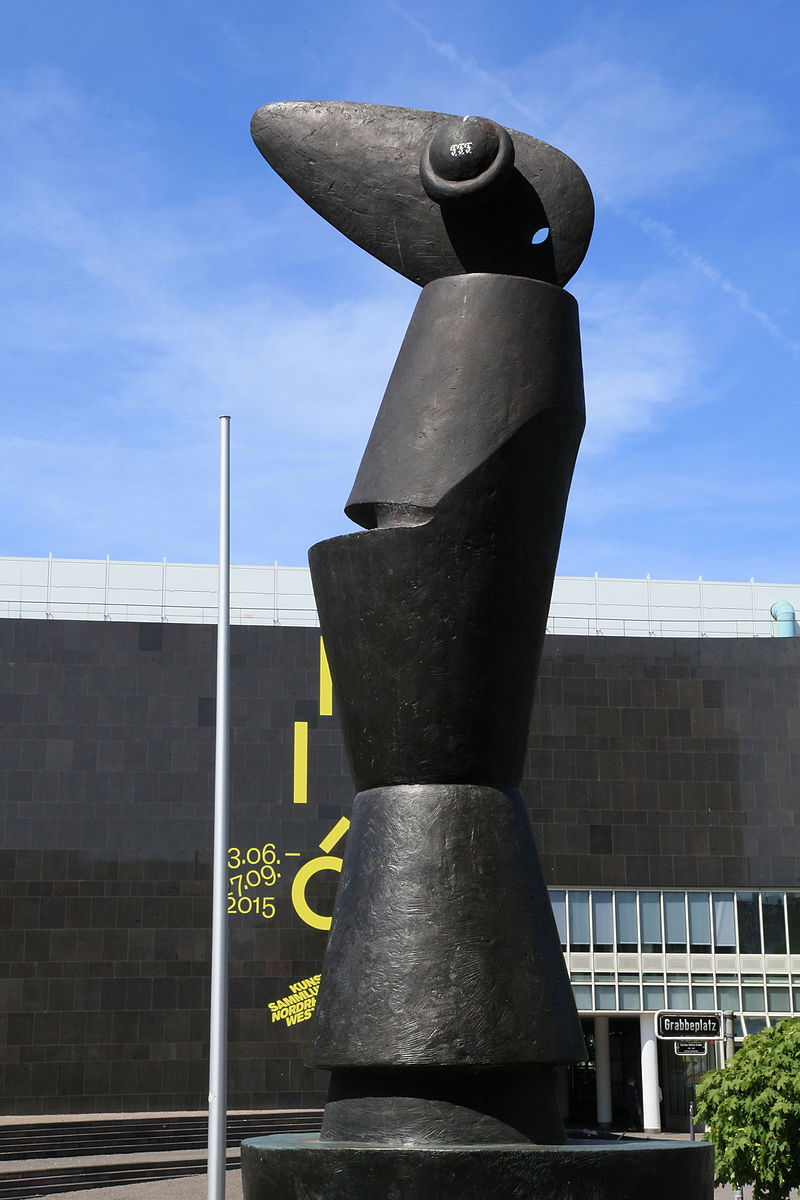
Gala Éluard was an inspiration to three Surrealist artists as the wife of poet Paul Éluard and Salvador Dalí and lover to Ernst. At one point, Éluard, his wife Gala, and Ernst formed a ménage á trois, living near Paris. Ernst created the work Gala Éluard (5.12.3) based on a photo of her eyes taken by Man Ray. He painted her forehead unfolding, releasing the dream-like mysteries of the unconscious mind. His use of rubbing on top of a surface to create texture is visible in the top half of the painting.
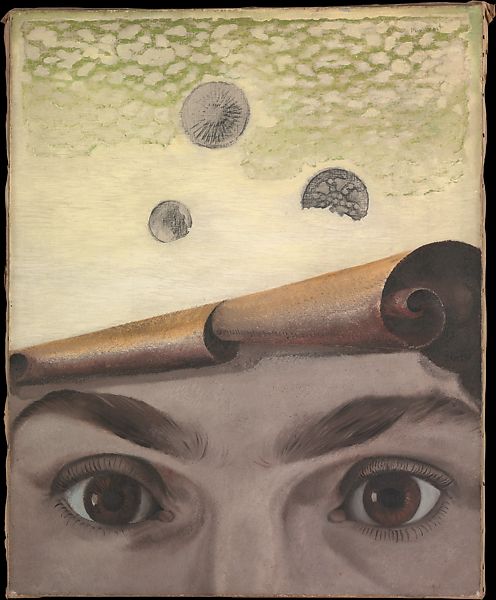
The Elephant Celebes (5.12.4) was based on a photograph Ernst found of a Sudanese corn bin. The work's title came from a German rhyme that began: "The elephant from Celebes has sticky, yellow bottom grease."[2] The odd elephant and headless figure and other elements have little in common, suggesting they are all parts of a dream centered on Freud's concept of free association.
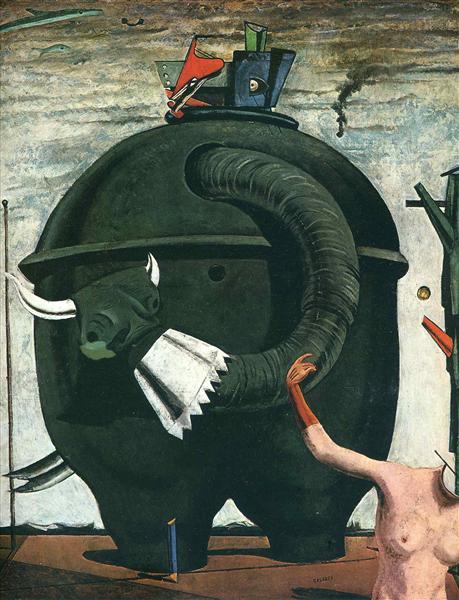
Salvador Dalí
Salvador Dalí (1904-1989) was born in Spain after his older brother Salvador died of meningitis, plunging his parents into despair. The concept haunted Dalí all his life, and Dalí frequently mythologized about his brother and included the concept of the dead boy in many paintings. Dalí recorded, "My brother and I resembled each other like two drops of water, but we had different reflections. Like myself, he had the unmistakable facial morphology of a genius."[3] He went to a local art school, his father even setting up a small exhibition of early drawings. In 1922, Dalí moved to Madrid and studied at the Real Academia de Bellas Artes de San Fernando. He was slight in stature, dressed unusually, and was perceived as an eccentric. As artists in Paris went to the Louvre to study, Dalí went to the Prado Museum to study the great works. At first, he experimented with Cubism until he traveled to Paris in 1926 and met many Surrealist artists, including Picasso and Míro. As Dalí formed his version of Surrealism, many thought his work was hallucinatory based on sexual anxiety and subconscious needs, often bizarre or grotesque themes. He also started a long-lasting affair with Gala Éluard, whom he eventually married, returning to Catalonia. In the 1930s, Dalí changed from a significant figure in the Surrealist movement to expulsion from a feud with Andre Breton. In the 1940s, he and Gala went to America, fleeing World War II, working in the movie industry before returning to Catalonia. In the 1950s, Dalí began his classical period based on historical, religious, or science themes, heavily focused on mysticism and illusionary images.
Dalí's flamboyance and dramatic imagination, along with his hallucinatory and paranoiac visions, allowed him to render the exceptionally unrealistic images as though they were something everyone recognized. The Persistence of Memory (5.12.5) is based in reality – the cliffs along the Catalonian coastline – and becomes filled with an unimaginable dreamscape. Hard, metallic decaying watches drape limply, representing time and permanence, losing their meaning. The atrocious creature in the center is a partial version of Dalí's face with something oozing from the nose. He believed he developed his own "paranoiac-critical method," cultivating self-induced psychotic hallucinations to create art. "The difference between a madman and me," he said, "is that I am not mad."[4]
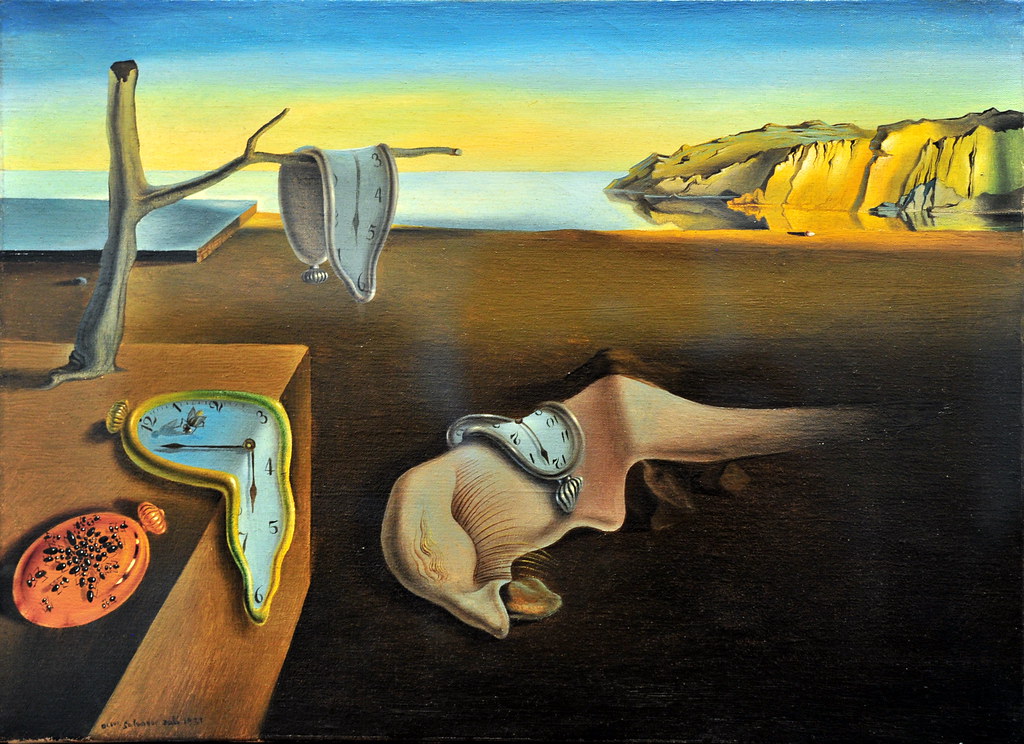
Dalí painted The Accommodations of Desire (5.12.6) in 1929 when he was having an affair with Gala, although she was married to Paul Éluard. The painting reflects Dalí's sexual anxieties about the affair. When they were out walking, he saw pebbles along the pathway and used the seven pebbles as the base to hold the images for his visions. He cut small pictures out of a children's book, each one a distinctive symbol portending the future; the lion heads were terrorizing, the ant colony symbolizing decay. The collaged figures blended into the saturated color, adding to the Surrealism of the subconscious perceptions of Dalí.
 Figure \(\PageIndex{6}\): The Accommodations of Desire (1929, oil and cut-and-pasted printed paper on wood, 22.2 x 34.9 cm) Public Domain
Figure \(\PageIndex{6}\): The Accommodations of Desire (1929, oil and cut-and-pasted printed paper on wood, 22.2 x 34.9 cm) Public DomainThe Temptation of St. Anthony (5.12.6) is Dalí's interpretation of the biblical story about the monk's travels through the deserts of North Africa where visions and assaults confront him. The hallucinatory and seductive battles inspired many artists. Dalí focused on images of the background and the tormenting creatures St. Anthony encountered. The lead, voluptuous horse, and the parade of elephants tower over the cowering monk kneeling in the corner, cross in hand. The erotic images of phallic architectural buildings and the nude woman balanced on the pedestal emphasize the eroticism and temptations in the desert. The dusty desert land anchors the dream-like image and low horizon as the figures and their long, exaggerated legs flow through the azure sky. The rhinoceros held a particular interest for Dalí; he believed its horn represented the perfection of a logarithmic spiral, the only one in the animal kingdom. He became obsessed with the rhinoceros at the age of nine and, as an adult, studied other artists' renditions of the oversized animal. He wrote, "not content to bring to the tip its nose one of the most beautiful logarithmic curves, but also in its backside, it bears a sort of galaxy of logarithmic curves in the form of a sunflower."[5] He painted many images of the rhinoceros and even wrote a magazine called Rhinoceros based on scientific theories.
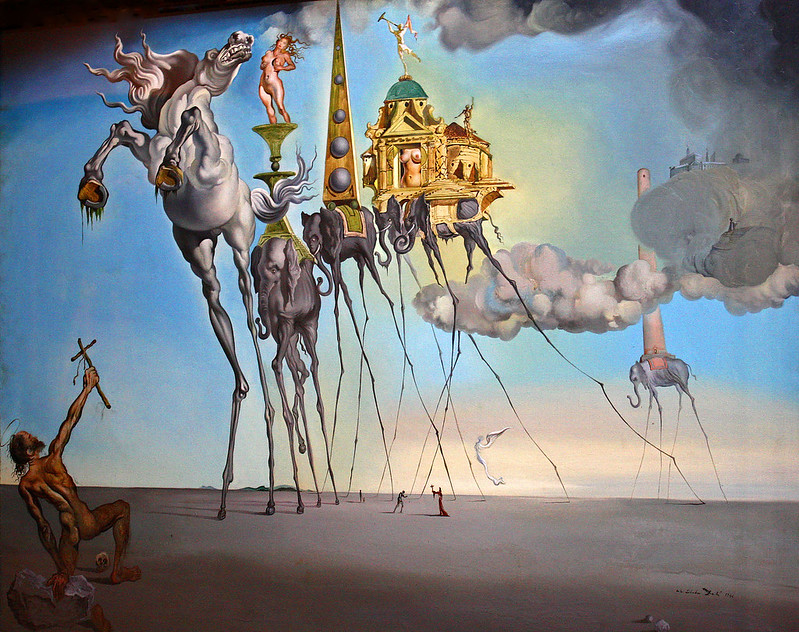 Figure \(\PageIndex{7}\): The Temptation of St. Anthony (1946, oil on canvas, 89.7 x 119.5 cm) CC BY-NC-ND 2.0
Figure \(\PageIndex{7}\): The Temptation of St. Anthony (1946, oil on canvas, 89.7 x 119.5 cm) CC BY-NC-ND 2.0Rinoceronte vistido con puntillas (5.12.7) is a massive sculpture Dalí created to demonstrate the strength and virility of the animal based on the horn and its phallic significance. The rhinoceros was clad with armor with sea urchins carefully balanced on its back.
Frida Kahlo
Frida Kahlo (1907-1954) was born in Mexico with the name Magdalena Carmen Frida Kahlo y Calderón; Kahlo is the family name of her father and Calderón the maternal last name. She started drawing as a child, although she did not consider an art career. At age six, she contracted polio, causing a permanent limp. In 1922, Kahlo went to the Escuela Nacional Preparatoria to study medicine at the prestigious school. Unfortunately, a bus collision left her with multiple broken bones and internal injuries when she was eighteen, leaving her with life-long pain. Her recuperation was extensive, and Kahlo started painting as she lay in bed. After the disastrous accident, she was in a body cast, bound to the bed. Kahlo's mother hung a mirror above her four-poster bed while she recovered, and her reflection became the main subject in her art throughout her life. Ultimately, Kahlo used her art to help her heal while she spent countless days alone in bed. Afterward, she was forced to wear orthopedic corsets, endured multiple spinal surgeries and many miscarriages. All of this pain became reflected in her artwork.
Kahlo grew up during the Mexican Revolution, an inspiration for her future political fervor. She met Diego Rivera, twenty years her senior, in 1927 and married him in 1929, accepting his infidelities. Both of them were active in political revolutionary groups supporting the communists and other protest groups. In the early 1930s, Kahlo and Rivera traveled through Mexico as well as the United States. Their marriage was turbulent as both had multiple affairs, including Kahlo's young sisters affair with Rivera and Kahlo's open bi-sexuality. They even divorced in 1940 and remarried again. Her health was always a problem and deteriorated in the late 1940s, finally dying as she slept in 1954, only 47 years old. Kahlo struggled to be the perfect Mexican wife for Diego and which clashed with her multicultural upbringing. One of Kahlo's most celebrated works, The Two Fridas (5.12.9), illustrates this struggle between wearing a traditional tehuana dress and a European Victorian dress. She completed the painting after her divorce from Rivera, a heart on each person. The heart of traditional Frida torn and cut, the scissors in her hand, blood dripping on the white dress. Dark clouds fill the background suggesting the turmoil of her feelings.

Kahlo passionately gathered Mexican folk art, especially toys, adorned ceramics, colorful textiles, and religious images, influencing her artwork. Her work reflected the art of Mexico, especially folk art and historical images from the pre-Columbian and Aztec societies, conquered Mexico's culture and revolutionary times, incorporating the culture of Mexico over time. Kahlo's work developed into mainly self-portraits or images of her friends, all based on her extraordinary imagination. She was often immobilized in a cast and forced to paint as she lay in bed. She even attended her first exhibition, transported by ambulance and lying in a four-poster bed the gallery set up for her, disregarding her doctor's orders. Kahlo's work frequently incorporated her physical or psychological pain along with the iconography of historical Mexican images. Kahlo also integrated motifs from nature, especially foliage from local flora and animals, adding a more realistic and organic look to her Surrealistic images. She wore elaborate clothing designed in the style of early Mexican costumes, clothing seen in her paintings. Her pain and agony were also visible in her work, her face contorted into a mask-like appearance, eyes staring, as internal organs spilled out from her body. She did not like to say she was associated with any movement, only declaring she was a Surrealist based on her reality, not dreams. Although some of the irrational impulses of Surrealist artists are visible in her work, Kahlo opens her own life and herself as the main subject and concern in her work. She stated, "They thought I was a Surrealist, but I wasn't. I never painted dreams. I painted my reality."[6]
Many cultures used monkeys as a cultural symbol, usually associated with lascivious and defined as lust, a primal image of a man in Mexico. However, Kahlo owned a pet spider monkey, incorporating it into her work, portraying the monkey as a protective symbol, an animal with its personality and soul. In Self Portrait with Monkeys (5.12.10), the monkeys encircle her, seemingly shielding her from those outside the painting. Kahlo started as a teacher at an art school in Mexico City when her injuries worsened, and she had to teach in her home, her class drifting away to only four students who stayed with her. Many believe she incorporated the four monkeys in this painting to honor those four students. The background is decorated with leaves, a typical adornment in her work, and a bird of paradise, a flower commonly found in Mexico. Kahlo said,
"I paint self-portraits because I am so often alone because I am the person I know best."[7]
.jpg?revision=1)
Most of Kahlo's paintings included elements of pain and suffering, a continual part of her life as she had several surgeries for her back and wore different rigid corsets for support. The Broken Column (5.12.11) is reminiscent of her hospitalization, her back broken, her agony and horrific pain evident in the painting. She used a metal column to represent her broken spine; the column fractured in multiple places and was seemingly ready to collapse. Her body was held together with a surgical brace as nails punctured her face and body. Her lower body is covered with a cloth resembling a hospital sheet. Despite the pain, she looks forward, a triumph over her situation. The image also demonstrates her as a young, still viable woman displaying the nude sections of her upper body. To create the painting, she used firm brushstrokes and well-defined colors.
.jpg?revision=1)
Kahlo started Portrait as a Tehuana (5.12.12) in 1940 after she divorced Diego Rivera, after ten years of marriage and was unwilling to tolerate his affairs any longer. She painted an image of Rivera on her forehead, giving the self-portrait the alternative names of Diego in My Thoughts and Thinking of Diego, demonstrating her continued love for him. For the self-portrait, she wore the clothing worn by the Tehuantepec women. On her head are leaves whose roots are similar to a spider's web, perhaps trying to entrap her feelings about Rivera. As with other self-portraits, she maintains the bold, self-assured image, staring forward, her dark eyebrows highlighting the directness of her eyes. Kahlo frequently wore the clothing of the Tehuana women, a pre-Hispanic people where women realized equality with their male counterparts; women also had strength and sensuality.
.jpg?revision=1)
In Self Portrait with Necklace of Thorns (5.12.13), Kahlo looks directly at the viewer. A thorn necklace smothers her throat and chest with the black love charm hummingbird, a pendant dangling from the thorns. However, this hummingbird is dead instead of lively and colorful. The monkey on her shoulder tugs at the necklace; the thorns are drawing blood. Because Rivera gave a monkey to Kahlo, some historians view the monkey as a symbol of Rivera inflicting pain with the thorns. The image is set in a background of leaves and insects, her face solemn as though she knows she has to endure the continual pain.
.jpg?revision=1)
Joan Miró
Joan Miró (1893-1983) was born in Barcelona, Spain, learned to draw at an early age, and attended art school and business school. The Cubists and Fauve continually inspired him; however, his early exhibition was controversial and avant-garde compared to the Impressionist style people were expecting. When Miró moved to Paris in 1920, at first, his work resembled Cubism until he became influenced by the writings of Sigmund Freud and the ideals of Surrealism with its revolution against the orthodox approach. He did not become one of the members of the Surrealist group; however, he did collaborate with Ernst and exhibited his work with the other Surrealists. At first, Miró worked with collages before moving to watercolors, pastels, lithographs, and even monumental bronze sculptures for public displays. His work was pictorial based on geometric shapes, abstracted objects, and biomorphic forms, creating his Catalan view of the subconscious and psychological interpretations. His work was balanced with the automatism and extemporaneity of Surrealism and the meticulous rendering of his abstracted finished works.
Miró liked to use bold colors founded on a limited palette, applying unblended colors next to each other with slight gradations of the colors on the flat backgrounds. He liked to use colors as a poet uses words or composer-defined notes for music. In Potato (5.12.14), he used the prominent color of white juxtaposed against the dark blue sky and a small patch of field. The immense female figure holds her arms out, her undulating, amorphous figure held in place by the red pole. The figure, which displays a black and brown breast squirting thread, is surrounded by other floating images; a red and yellow woman who appears as a butterfly or the creature climbing the ladder. Based on the title, a real potato seems to be wedged in the figure's forehead as tendrils grow upward, an accurate representation in the Surrealism of the painting.
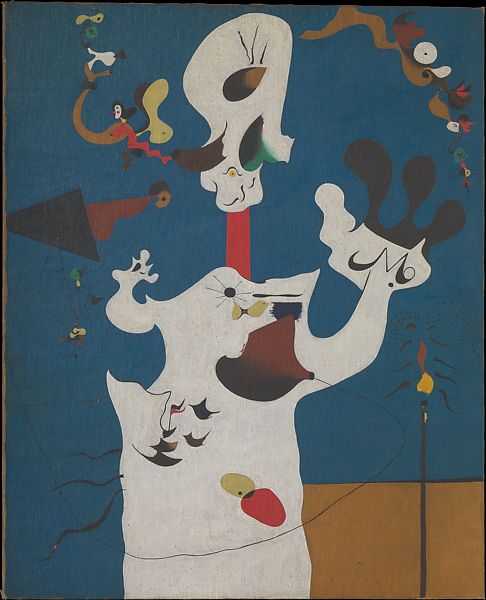
Miró returned to Spain in 1940, working on his Constellation series, a set of twenty-three images made from gouache on paper over twenty-one months. The entire paper of Constellation Toward the Rainbow (5.12.15) is covered with black and red geometric shapes, hourglass formations, stars, or abstract shapes, all connected with thin, dark lines, the blue star and yellow triangle moving the viewer around the image. Miró made all the series with bright colors and spontaneous, joyful silhouettes, bringing an escape from the hardships of World War II. In 1939, he told an interviewer, "a new stage in my work began which had its source in music and nature. It was about the time that the war broke out. I felt a deep desire to escape. I closed myself within myself purposely. The night, music, and the stars began to play a major role in suggesting my paintings."[8]
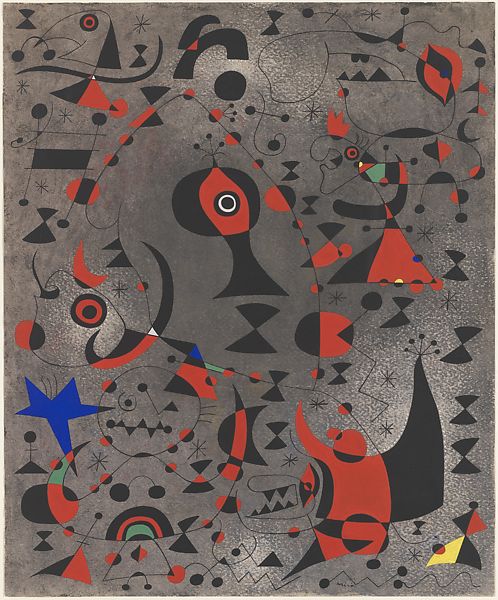
Miró's sculpture, Lunar Bird (5.12.16), is a hybrid creature, part crescent moons, horns of the bullfighting bull, or parts of a bird. The jutting arms appear as wings of a bird ready for flight as the projecting crescents on its head materialize as horns. He frequently used cosmic concepts as a recurring idea, joining the correlation of the sky and land. In the Catalonia region, birds and lunar elements were common themes. Miró shaped the work by hand to produce a more organic shape, believing he created a more life-like hallucinatory organism he could not achieve with a painting.
Remedios Varo Uranga
Remedios Varo Uranga (1908-1963) was born in Spain. Her original name was Maria de los Remedios Alicia Rodriga Varo y Uranga, named to honor the Virgin of Remedies (Virgen de los Remedios), a child born shortly after her older sister passed away. As a hydraulic engineer, her father recognized his daughter's artistic talent and had her draw his technical plans to learn perspective and geometric shapes. Her life was also filled with an education from books based on science, mysticism, philosophy, and her Catholic faith, concepts found in her artwork. Initially, she attended the Escuela de Bellas Artes as a teenager. Uranga married and spent a short time in Paris before returning to Barcelona, a center for avant-garde artists. In 1937, she left her husband in Spain to fight the civil war and fled to Paris, where she had several affairs before escaping to Mexico when the Nazis invaded Paris. Uranga remained in Mexico for the rest of her life. During her early career, she demonstrated elements of Surrealism and spent her time in Paris with other Surrealist artists working as an illustrator for avant-garde magazines. During her earlier period in Mexico, muralism was the dominant artistic venue, Surrealism not acceptable. Other artists fled to Mexico to escape the war in Europe, forming a local art colony and bringing changing ideals of art.
The allegorical styles of Renaissance art stimulated Varo's art, concepts she brought to her Surrealistic paintings. She generally used oil on prepared Masonite panels, painting with delicate brushstrokes applied closely next to each other. The female Surrealists were not accepted into the male echelon of artists. The female artists had to develop different characteristics, and Varo generally displayed images of women in defined spaces, mostly with androgynous and spiritual figures. Ascension at Mount Analogue (5.12.17) depicts the lone figure awakened and starting a long ascent up the mountain. The figure seeks "a golden alpine flower that could be picked only if one did not want it; a flower said to be the source of spiritual purification, inner peace, and immortality."[9] The flower symbols for spiritual refinement and the transformation of the person. Varo uses red-orange as the powerful color of the gown and wings to act like sails. The figure moves from the cave and faces the mountain; the mountain is a frequent symbol of spiritual transformation as a connection between the earth and sky.
_Remedios_Varo_-_Ascensin_Al_Monte_Anlogo_(5579572452).jpg?revision=1)
Woman Leaving the Psychoanalyst (5.12.18) portrays a woman in the courtyard, her face imprinted in the fabric of her gown, a disembodied head she appears to be dropping into the pool, little emotion on her face. The basket under her cloak contained what Varo defined as "yet more psychological waste."[10] As she continues along the pathway of self-reflection, she will lose more waste. Varo used bright colors positioning the olive green against the yellow-brown walls. The white-winged headdress and white head move the viewer around the image. The clouds in both images were created with a technique called soufflage, blowing the paint on canvas with a straw, giving an otherworldly appearance.
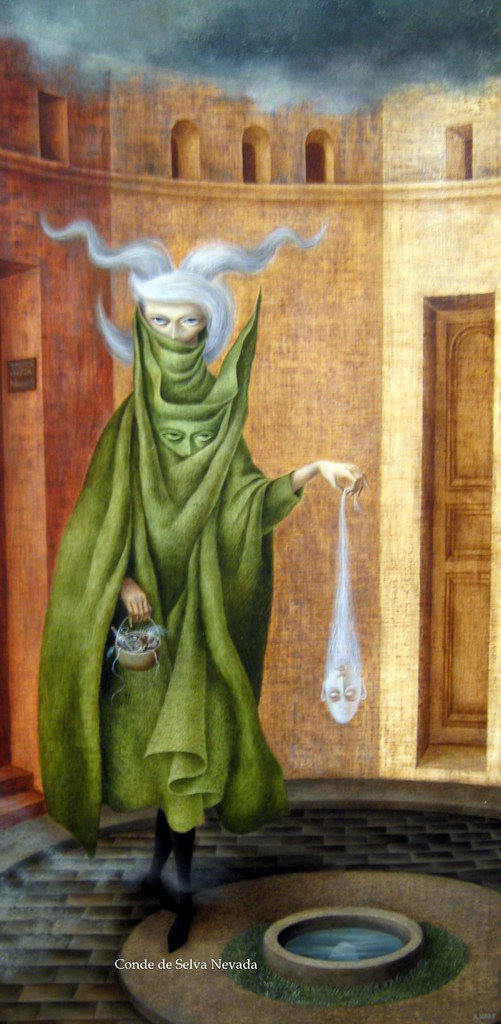
René Magritte
René Magritte (1898-1967), was born in Belgium; his father was a tailor and his mother a milliner. His mother suffered from mental illness and tried multiple suicide attempts before finally drowning in a river. Theoretically, when his mother was found in the water, her clothing covered her face. Magritte frequently obscured the face in his paintings, a concept of past grief. He studied in Brussels at the Académie Royale des Beaux-Arts. Magritte served in the Belgian army during World War I and married after the war. In 1926, he started painting, and his first exhibit was a failure, motivating him to relocate to Paris. He was a friend of Andre Breton and became part of the Surrealist group and exhibited with Ernst, Miró, Picasso, and other Surrealists. He was influenced by the writings of Sigmund Freud, joined the Communist Party for a while, and continued to exhibit in America and London. Magritte returned to Belgium, which was under German occupation during World War II. He stayed in Brussels the rest of his lifetime, painting in a Surrealist manner throughout his career. He painted dream-like images, sometimes similar to the automatism of Joan Miró or the illusions of Salvador Dalí. Magritte said, "If the dream is a translation of waking life, waking life is also a translation of the dream."[11]
Magritte painted related scenes based on recurring themes, often with floating components, an inanimate object in a person, or a painting within another painting. He also used a well-known painting as a base concept and transformed the image into a unique Surrealist work. Magritte believed the concept of the concealed image was more important than the visible sections, leaving the mysterious open to interpretation. The Eternally Obvious (5.12.19) was based on a prototype he made earlier. He painted the nude image of his wife and cut the work into sections, eliminating some parts and reassembling the body into five different self-contained units. The painting brings the perception of a female while leaving the viewer to mentally construct a complete figure.
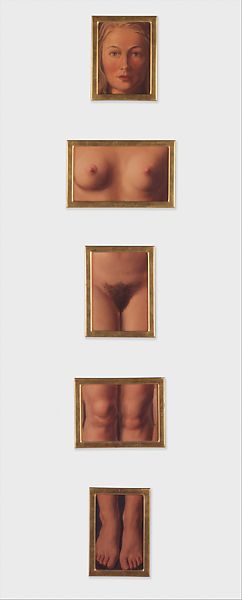
La Decalcomanie (5.12.20) was a commission of a patron for the ballroom in his London home. Standing in front of a mirror, a viewer would expect a face to be reflected; instead, Magritte reproduced another image of the back of the man's head. This scene leaves the viewer to wonder what the man looks like and why his reflection is backward. The book laying on the mantle is appropriately reflected in the mirror. Magritte used deep browns in the painting, the reflection on the faces and collars defining each person.
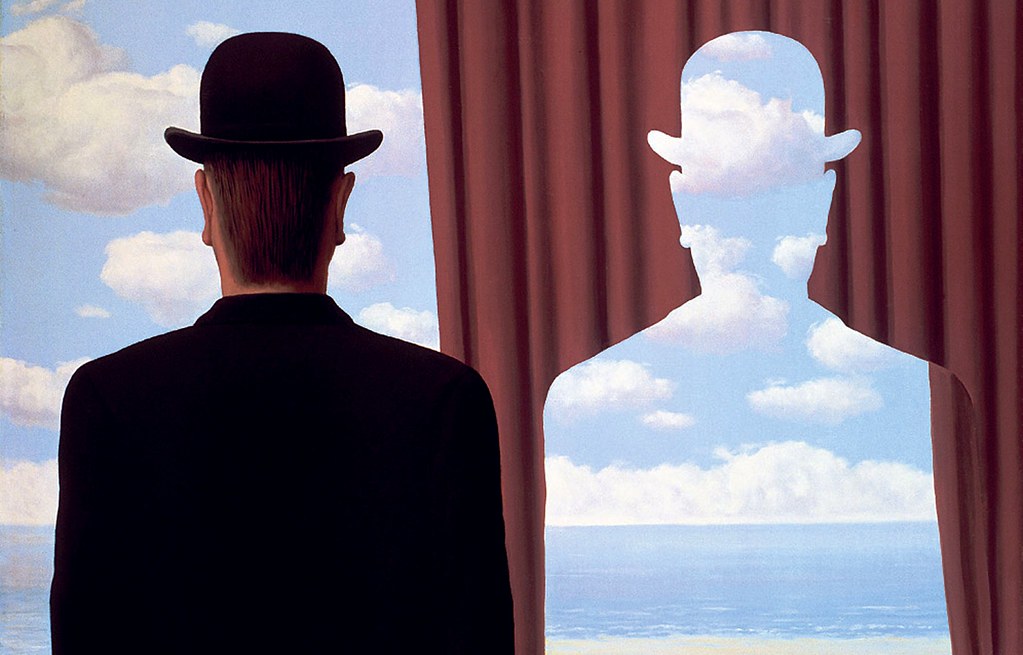
Magritte made numerous versions of The Empire of Light (5.12.21), each one a nocturnal scene of a neighborhood in an odd juxtaposition with the light blue cloudy sky, a strange paradox of day and night. The town and trees a thrust into the deep darkness of night, lights were showing in the windows of the houses, the irrational luminous blue sky bringing an uneasy feeling, everything out of context. The scene is characteristic of Magritte's Surrealist style, a contradiction within the same scene, challenging the viewer's mind.
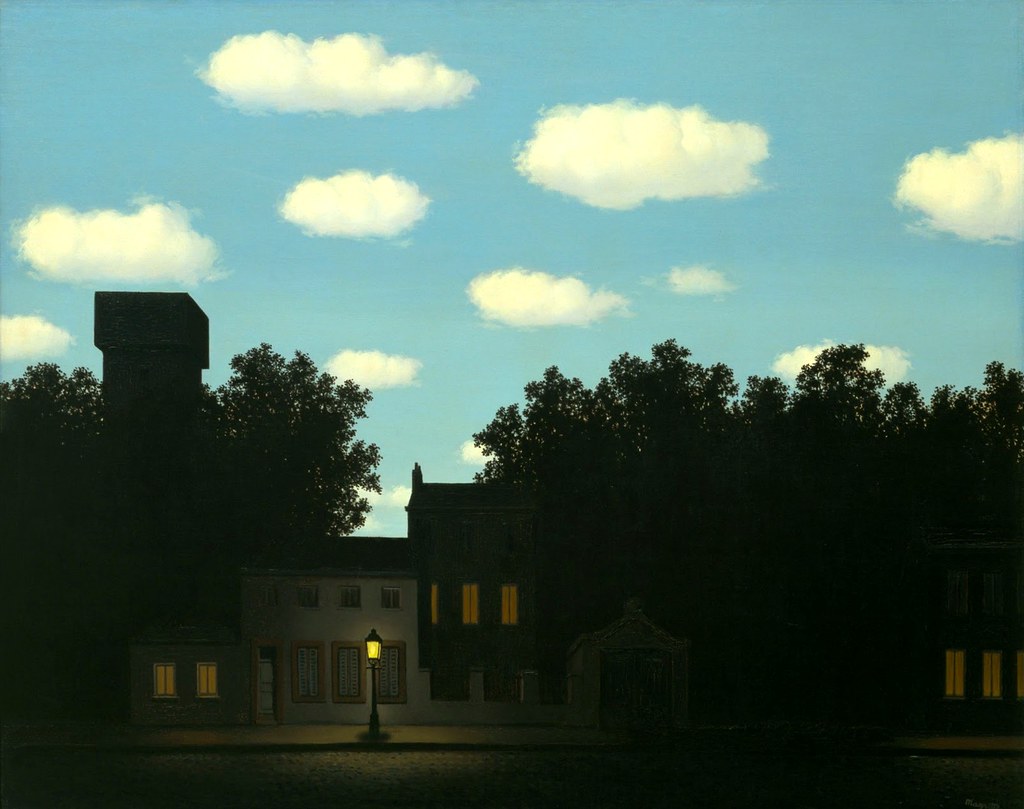 Figure \(\PageIndex{21}\): The Empire of Light (1950-1954) by Ωméga CC BY-SA 2.0
Figure \(\PageIndex{21}\): The Empire of Light (1950-1954) by Ωméga CC BY-SA 2.0Leonora Carrington
Leonora Carrington (1917-2011) was born in England; her father gained his wealth in manufacturing. She was expelled from different schools for poor behavior and educated by numerous tutors and governesses, Despite her father's disagreement, she finally went to art school in London. Carrington saw the works of Max Ernst at a Surrealist exhibition in London and was attracted to his work and Ernst himself. When they met in person, Ernst left his wife, and he and Carrington moved to France, supporting each other's careers. At the onset of World War II, Ernst, a German, was arrested by the French government as a hostile alien, released by the intervention of his friends. Shortly afterward, the Nazis invaded France, and the Gestapo arrested Ernst as a degenerate artist. He escaped to the United States, leaving a devastated Carrington behind. She went to Spain and suffered a mental breakdown. Her parents had her hospitalized, and she was treated with highly potent drugs. Carrington escaped and to the Mexican Embassy, seeking refuge. During this time, Ernst married and never resumed their relationship. Carrington married Renato Leduc, the Mexican Ambassador, as a marriage of convenience and a way to travel to Mexico under diplomatic immunity. Although she divorced Leduc, she lived in Mexico the rest of her life, marrying again and having two sons. Carrington was active in the feminist movement in Mexico and wrote many articles about issues of masculine authority or Surrealist-themed novels, including The Surreal Life of Leonora Carrington or Down Below.
As a rebellious daughter, Carrington frequently included a woman trapped in creepy situations, crumbling houses, or claustrophobic enclosures. She might be imprisoned by a monster or religious clergyman or another restraining persona. The images are a reflection of her own tumultuous early life. Her painting, Self-Portrait (5.12.22), depicts a female figure in a chair with wild dark hair. Carrington frequently included horses in her paintings as representations of freedom, the horse her alter-ego. The white horse, her surrogate, is running free outside the window, the moving, tailless hobby horse trapped inside the room. The room is devoid of any furnishings except the chair. The hyena dances in front of her outstretched hand, imitating her posture. Carrington also used the hyena in her paintings and writings, often a surrogate for her image. In one story she wrote, a debutante brought a hyena to the party to prove the power of women. Carrington told an interviewer, "I'm like a hyena, I get into the garbage cans. I have an insatiable curiosity."[12]
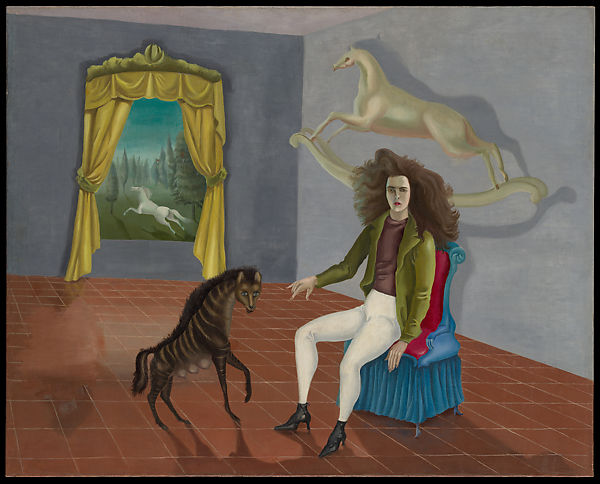
In the Magical World of the Mayans (5.12.23), characters are based on Carrington's interest in Mayan mythology. The major figures line the bottom of the painting as though actors aligned on the stage in a play. Carrington was focused on magical realism using images from the Popol Vuh, the sacred book of the ancient Mayans intermixed with Celtic mythology which she used in many of her paintings. She traveled to San Cristobal de las Casas to study the Mayan culture and then created this magnificent mural distinctly divided into three layers; heaven, earth, and the underworld.
-1.jpg?revision=1) Figure \(\PageIndex{23}\): The Magical World of the Mayans (1952, oil and tempera on canvas, 54.5 x 91.5 cm) CC BY 2.0
Figure \(\PageIndex{23}\): The Magical World of the Mayans (1952, oil and tempera on canvas, 54.5 x 91.5 cm) CC BY 2.0 Carrington also made multiple oversized bronze surrealistic sculptures (5.12.24) using her recurring animal themes of hyenas, horses, and even half-crocodiles, some resembling ghosts or giant women, winged animals, or a conglomerate of an animal. All of the sculptures were based on folklore or myths, often in dream-like formats. She did not define the meaning of her sculptures, preferring the viewers to develop their assumptions and thoughts when they observed her work.
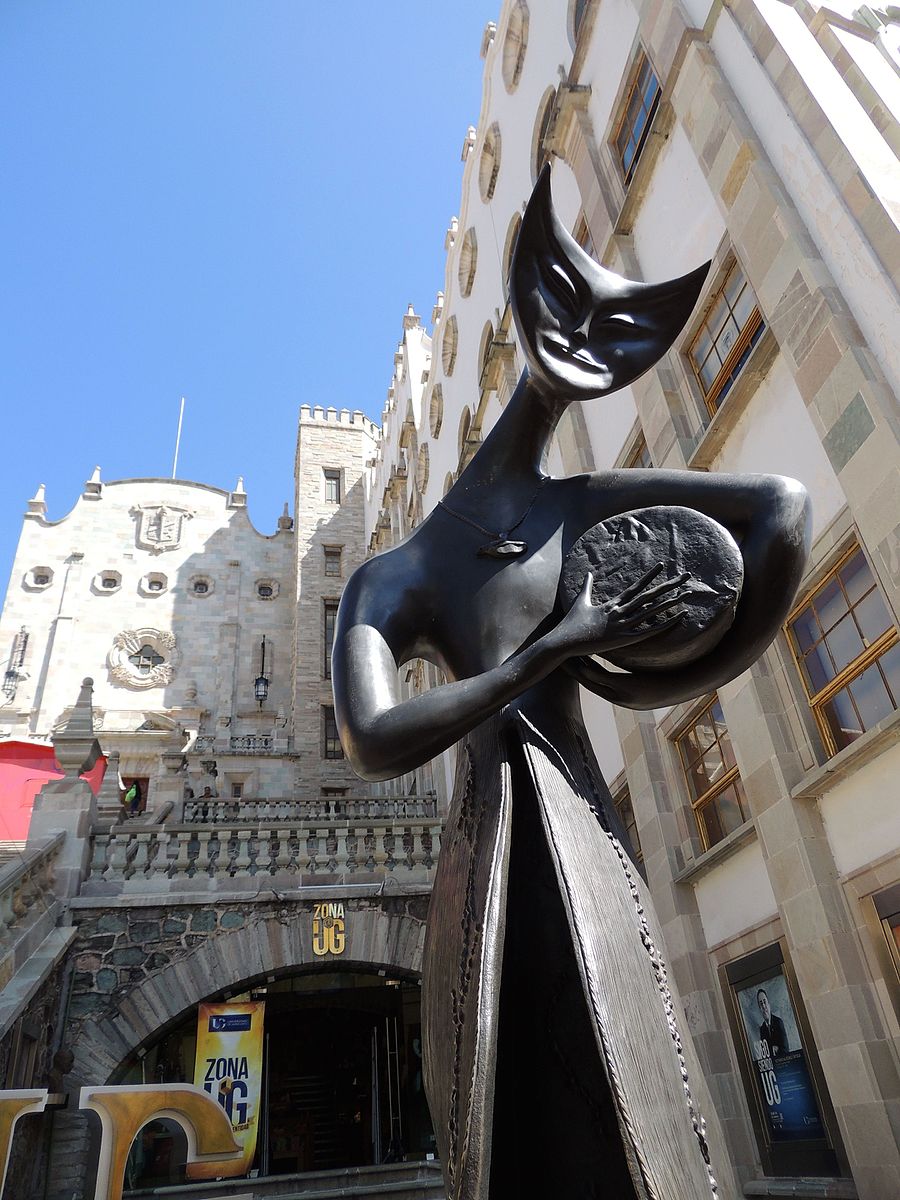
Marc Chagall
Marc Chagall (1887-1985) was born as Moishe Shagall in Russia, a part of the extensive Jewish community in Vitebsk, now part of Belarus. His father worked for a herring dealer, carrying heavy barrels of fish for low wages. Chagall frequently used fish as a motif in his artwork to honor his father. Jews were confined to the town under the control of the Russian government, one of the multiple Jewish villages. Pogroms were a regular part of life, bringing a continual fear into the lives of the people. Some Jewish artists hid or denied their Jewish background, while others expressed the concepts of their Jewish roots, incorporating their beliefs into their work. Chagall adopted the latter view and embraced his religious experiences into his artwork, however still secular.
Chagall's art can be understood as the response to a situation that has long marked the history of Russian Jews. Though they were cultural innovators, Jews were considered outsiders in a frequently hostile society. Chagall himself was born to a family steeped in religious life; his parents were observant Hasidic Jews who found spiritual satisfaction in a life defined by their faith and organized by prayer.[13]
Jewish children were excluded from public schools and universities; Chagall was educated at a local religious school. In high school, his mother supposedly bribed a professor to let him attend the regular school. To learn how to draw, he copied illustrations from library books, developing his interest in art. In 1906, Chagall went to Saint Petersburg, the center of Russian art, where he attended one of the art schools, studied the old masters, learned contemporary art styles, and moved beyond his local village's images. He also met the woman whom he would marry as the love of his life. By 1910, he went to Paris, unable to speak French, yet became friends with other avant-garde artists and attended academies. Paris was also filled with other artists from Russia, bringing continual reminders of the homeland.
He returned to Russia and married his love, Bella Rosenfeld. World War I started, and they had to remain in Russia, where he achieved success as an avant-garde artist. The Bolshevik Revolution followed the end of the war. Because he was a successful artist in Russia before the revolution, he had more freedom. He created a Jewish art school, worked as a stage designer for a major Jewish theatre, developing new murals for set designs, a genre he continued periodically. By 1923, life in Russia was grim, poverty was the rule, and he moved back to France, traveled throughout Europe and the Middle East, continuing to develop his reputation as an illustrator and painter. As the Nazi government grew and started to invade other countries, the high-profile Jewish Chagall was in great danger, and he and Bella fled to America. He was deeply distressed by the news of the destruction of his native village of Vitebsk and the forced evacuation to the concentration camps. His wife also died in 1944, and he returned to France at the end of the war.
The early Chagall incorporated aspects of Fauvism and Cubism in his style, then moved to the Surrealist dream-like images, abstracted, hybrid shapes, detached positions in unusual juxtapositions, developing his unique style. After Chagall's wife died while they were in America, he was unable to paint for months. To My Betrothed (5.12.25) is a subject matter Chagall painted frequently. The fantastical painting depicts the theme of beauty and the beast with an intermingling of arms and legs. Chagall frequently used an animal as a substitute for a person, giving the painting a sense of absurdity as the yellow-headed bull is dressed in a red robe. Everything is brightly colored in the middle part of the canvas, presenting a strange relationship. "But perhaps my art is the art of a lunatic,…mere glittering quicksilver, a blue soul breaking in upon my picture." [14]
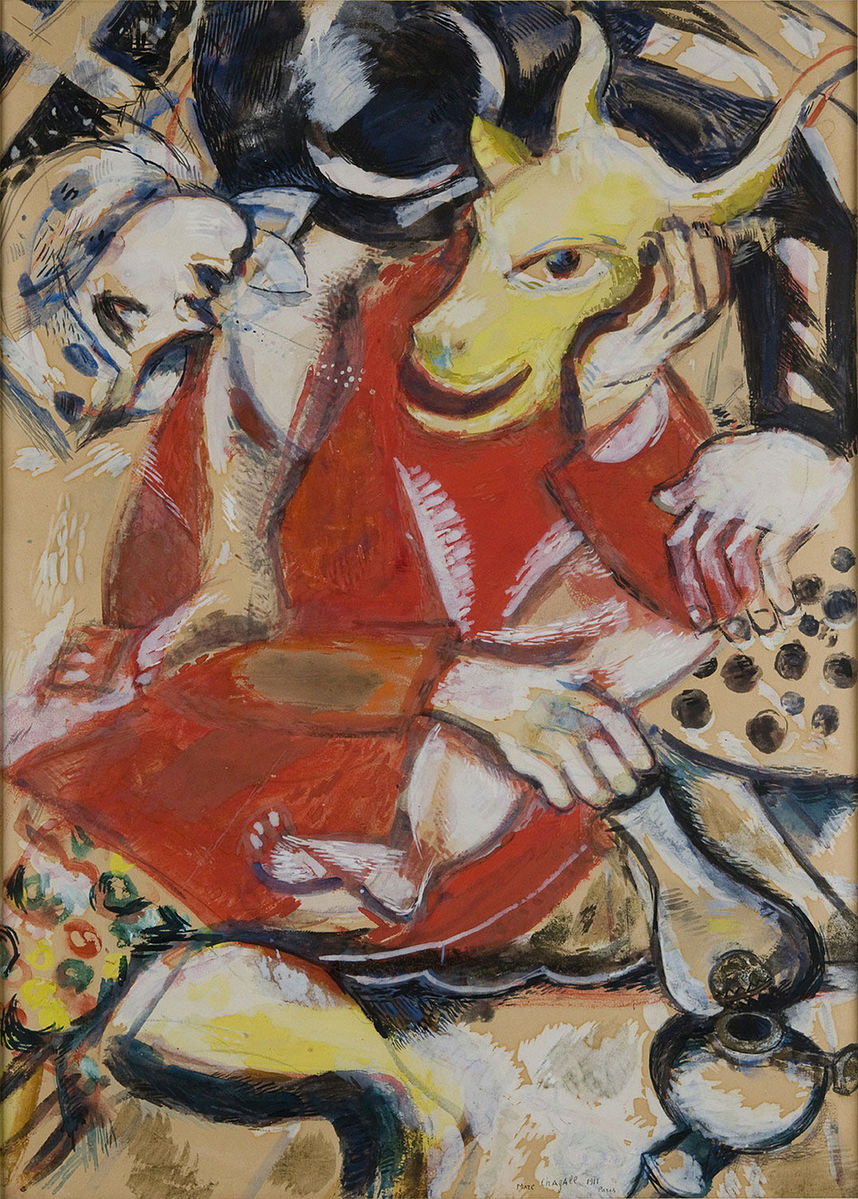
The Falling Angel (5.12.26) is a painting Chagall started in Paris in 1922 and finished in 1947 when he returned to Paris. He combined a concept from the Bible and Torah juxtaposed in a modern world, a world with significant changes over the period he worked on the painting. Initially, the work included an angel and the Jew, representing the exoneration of the manifestation of evil as described in the Old Testament. However, in the later years, he added other images and motifs from his Russian life, Jewish beliefs, and even some Christian symbols, such as the candlestick. Resembling a Shabbos candlestick, the flame is still burning, perhaps demonstrating the longevity of Judaism. The Jewish man is holding a Torah scroll, looking towards the angel falling, seemingly trying to distance himself from the destruction of the times. The goat at the bottom is an animal Chagall frequently incorporated, probably representing the small villages.

Kay Sage
Kay Sage (1898-1963) was born in New York, her father was wealthy from the timber business and was a longtime state senator. Her parents divorced shortly after Sage was born, and her mother moved with Sage to Europe. Her father continued to support her, and she attended private schools and formal training in art. She married in 1923 and, for ten years in Italy, lived a socialite's life which she considered throw away years with little purpose, then divorced her husband. Sage moved to Paris and became enamored with Surrealism, painting and exhibiting her work. She also met her next husband, Yves Tanguy, who was a close friend of André Breton. Although still married, Tanguy was separated from his wife, and after meeting with Sage, he divorced his wife. Sage had a lot of money from her father's estate and frequently helped support other artists, sometimes accused of having an arrogant attitude and deemed a princess. When Germany invaded Poland, starting the war, Sage returned to America and helped establish a Surrealist community in New York City, complete with exhibitions. She married Tanguy in 1940, and they moved from their studios to a farm. Although she developed a moody or unapproachable character, she did gain her reputation as an artist. During their marriage, Tanguy was abusive; however, when he died in 1955, she was devastated and seldom painted afterward.
Unusual Thursday (5.12.27) depicts a scene of a desolate landscape of architectural, pyramidal shapes in beige colors and deep shadows from an unseen sun. An eerie skeletal shape stands in the foreground, draped in orange. Critics felt she had "a feel for drapery as well as for architectural forms…the work is seen as 'strong and attractive,' and the use of color' persuasive.'"[15]
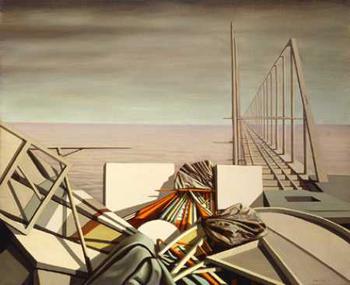
In the Third Sleep (5.12.28), she displays her ability to develop the draping images and the large divided shapes that rise out of the structure, jutting across the stark landscape. Again, Sage used a limited palette, giving white the primary position and deep shadows across the structure. Two small shapes appear as buildings; white and shadows balance the major shape as a small red wall running through the structure encircling the parts. As in both paintings, Sage uses a flat monotone and cloudless sky with little change from the horizon upward. They both have a surreal dream-like state found in the subconscious. Sage said, "things are half mechanical, half alive."[16]
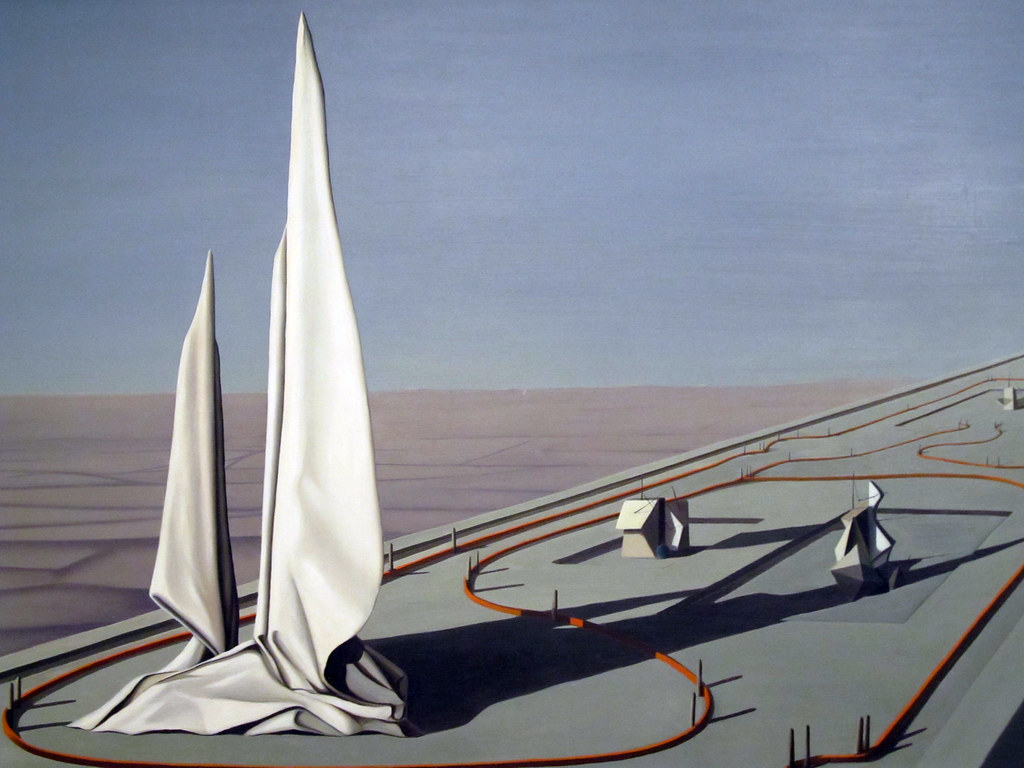
Tomorrow is Never (5.12.29) was painted after she stopped working five months after her husband died. Sage used the imagery of landscapes to depict the subconscious and the psychological cycles of existence. She continued to combine surreal landscape backgrounds with draped figures, trapped inside the lattice-like structures arousing positions of entrapment and disarticulation, the melancholy gray tones adding to the feeling. The image was her last major painting before she committed suicide in 1963.
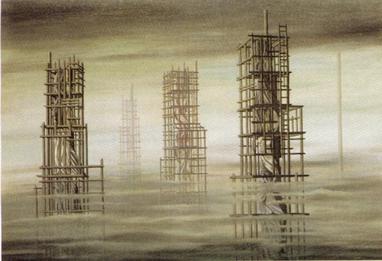
Dorothea Tanning
Dorothea Tanning (1910-2012) was born in Illinois, attending the local high school and a few years in college. She wanted to pursue art and moved to Chicago and then to New York in 1935, working as an illustrator in the fashion industry. A local gallery exhibited her work and introduced her to other Surrealist artists, including Max Ernst. Although Ernst was married, he left his wife and moved in with Tanning, whom he later married. Over the years, they lived in Sedona, Arizona, Paris, and New York. In Sedona, she found a place of unique views, the prickly plants, the immense red rocks, the arid desert, and the bright blue skies. Tanning developed friendships with other Surrealist painters and writers, observing their methods as she taught herself the necessary skills. Many of them visited Ernst and Tanning in Sedona. Tanning used the characteristic Surrealist techniques of meticulous features with careful brushstrokes. Her early years and through World War II were her most productive. Over time, she also expanded her styles to follow the new methods and movements. Tanning was always interested in literature and writing, and later in her long life, she focused on writing, and publishing many poems.
In the early years of her career, Tanning's work was more exact figurative executions in dream-like settings, and imaginative stories. Tanning wanted viewers to find hidden places and transformed images. She loved to include doors in her images (and dogs), adding doors everywhere; doors were open, closed, inside and outside; doors leading to nothingness. Many Surrealist painters used repetitive elements to create a thread in their paintings; Magritte's apples or Dali's clocks. Her doors brought the mystery, of what was behind the door or where did it lead, doors appearing more sinister than welcoming.
Eine Kleine Nachtmusik (5.12.30) displays the hotel corridor; the two girls dressed in tattered skirts appear to be sleepwalking as the enormous sunflower sends out menacing tendrils toward the girls. One of the doors is ajar with the light on, perhaps a refuge for the girls, an escape, yet what would happen if they entered the room. As Tanning said, "Behind the invisible door (doors), another door; more doors no doubt, new dimensions, deeper down the rabbit hole."[17]
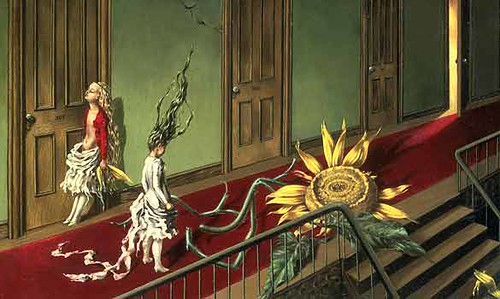
Tanning generally used female figures in her painting. Some feel she painted about her childhood and family; however, she stated she had a happy childhood and believed enigma was good, forcing viewers to explore beyond what they see. She did grow sunflowers by her Sedona house and was fascinated by their giant size and used it to demonstrate the unknown forces in our lives, saying, "It's about confrontation. Everyone believes he/she is his/her drama. While they don't always have giant sunflowers (most aggressive of flowers) to contend with, there are always stairways, hallways, even very private theatres where the suffocations and the finalities are being played out."[1] Guardian Angel, (5.12.31) was painted when Tanning moved to a small desert town in the Southwest and enjoyed her creative freedom. She gave into an illusion between reality and dreams and let her imagination run on her canvas. The painting is monochromatic with a spot of red in the lower part drawing your eye into the dream.
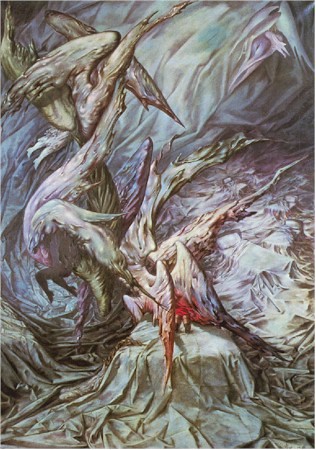
By the start of World War II, avant-garde movements changed, and Abstract Expressionism became the latest form, generated by the Surrealist artists and supporters. They fled Europe for the United States. Surrealism brought an escape from realism and the manifestation of unusual humor. The movement influenced the rise of abstract, pop art, op art, and other forms of expressive art. The influence of Surrealism continues today in movies, the internet, advertisement, and the ability to express spontaneity and fantasy. Artists can express emotions and innovations because the Surrealists reimagined and restructured art.
Surrealism injected obtuse humor, weird dreams, religious opinions, and the hidden subconscious into art. Each artist was interpreting their strange views of the unusual world found in their imagination. The use of color was important in each artist's painting, the bold reds of Chagall, the monotone of Sage, or the contrasts of Dalí. The movement was another aspect of their paintings, from the swirling of Tanning to the stillness of Magritte.
[1] Retrieved from https://www.newyorker.com/books/page-turner/leonora-carrington-rewrote-the-surrealist-narrative-for-women
[2] Retrieved from https://www.tate.org.uk/art/artworks/ernst-celebes-t01988
[3] Dali, S. (1993). The Secret Life of Salvador Dalí, Dover Publications, p. 2.
[4] Retrieved from https://www.moma.org/collection/works/79018
[5] Retrieved from https://www.thedaliuniverse.com/en/news-dalis-fascination-the-rhinoceros
[6] Retrieved from https://www.sfmoma.org/artist/frida_kahlo/
[7] Retrieved from https://www.fridakahlo.org/self-portrait-with-monkey.jsp
[8] Retrieved from https://www.metmuseum.org/art/collection/search/490007
[9] Haynes, D., The Art of Remedios Varo, Issues of Gender Ambiguity and Religious Meaning, Woman’s Art Journal, Spring/Summer 1995, 16/1, p. 31.
[10] Derks, M. (2011). Translating Magic: Remedios Varo’s Visual Language, University of Missouri-Kansas City, p.55.
[11] Retrieved from https://www.renemagritte.org/
[12] Wise, S. (2019). Leonora Carrington: A Bestiary, Western Kentucky University, p. 20.
[13] Dallmayr, F. (2020). Marc Chagall The Artist as Peacemaker, Taylor & Francis. Retrieved from https://books.google.com/books?id=Vy3tDwAAQBAJ&pg=PT41&lpg=PT41&dq=Chagall%27s+art+can+be+understood+as+the+response+to+a+situation&source=bl&ots=xxT94FNZmG&sig=ACfU3U3ayX7zxNSIQCxYQL8PcTuF1lIeYg&hl=en&sa=X&ved=2ahUKEwjR8LHepJ7rAhW6GTQIHVAJB2M4FBDoATAJegQIChAB#v=onepage&q=Chagall's%20art%20can%20be%20understood%20as%20the%20response%20to%20a%20situation&f=false
[14] https://www.marcchagall.net/cow-with-parasol.jsp
[15] Suther, J. (1997). A House of Her Own: Kay Sage, Solitary Surrealist, University of Nebraska Press, p. 111.
[16]https://artmuseum.williams.edu/kay-sage-serene-surrealist/
[17] Retrieved from https://lucywritersplatform.com/2019/04/03/dorothea-tanning-at-tate-modern/
[18] Retrieved from https://www.tate.org.uk/art/artworks/tanning-eine-kleine-nachtmusik-t07346


